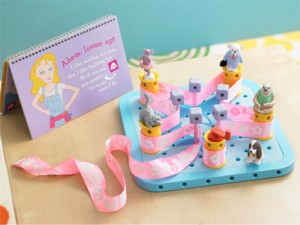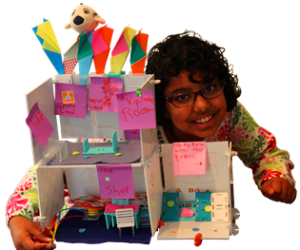This story about GoldiBlox, was supposed to be a ‘feel good’ piece about the company, girls, and STEM (science, technology, engineering, and mathematics)—but that was last week. At this point (Nov. 26, 2013), we can add a squabble over intellectual property (copyright) to the mix.
GoldiBlox, a company that makes engineering toys for girls (previously mentioned in my Dec. 6, 2012 posting) has produced an advertisement that has been attracting a lot of interest on the internet including this Nov. 19, 2013 story by Katy Waldman for Slate (Note: Links have been removed),
This is a stupendously awesome commercial from a toy company called GoldieBlox, which has developed a set of interactive books and games to “disrupt the pink aisle and inspire the future generation of female engineers.” The CEO, Debbie Sterling, studied engineering at Stanford, where she was dismayed by the lack of women in her program. (For a long look at the Gordian knot that is women’s underrepresentation in STEM fields, … . Sterling wants to light girls’ inventive spark early, supplementing the usual diet of glittery princess products with construction toys “from a female perspective.”
We love this video because it subverts a bunch of dumb gender stereotypes—all to the strains of a repurposed Beastie Boys song. [emphasis mine] In it, a trio of smart girls could not be less impressed by the flouncing beauty queens in the commercial they’re watching. So they use a motley collection of toys and household items (including a magenta feather boa and a pink plastic tea set) to assemble a huge Rube Goldberg machine. …
Here’s the video (no longer available with Beastie Boys parody song as of Nov. 27, 2013; I have placed the latest version at the end of this posting),,
You can find GoldieBlox here.
Things have turned a little since Waldman’s rapturous story. The Beastie Boys do not want their music to be used in advertisements, of any kind. From Christina Chaey’s Nov. 25, 2013 article for Fast Company,
Beastie Boys members Mike D and Ad-Rock, who survive the late Adam “MCA” Yauch, have issued the following open letter addressed to GoldieBlox:
Like many of the millions of people who have seen your toy commercial “GoldieBlox, Rube Goldberg & the Beastie Boys,” we were very impressed by the creativity and the message behind your ad. We strongly support empowering young girls, breaking down gender stereotypes and igniting a passion for technology and engineering.
As creative as it is, make no mistake, your video is an advertisement that is designed to sell a product, and long ago, we made a conscious decision not to permit our music and/or name to be used in product ads. When we tried to simply ask how and why our song “Girls” had been used in your ad without our permission, YOU sued US.
Chaey’s article goes on to document responses from other musicians about this incident and notes that GoldiBlox has not commented.
Techdirt’s Mike Masnic, also has a Nov. 25, 2013 article on the topic where he notes that neither party has filed suit (at least, not yet),
Now, it is true that some in the press have mistakenly stated that the Beastie Boys sued GoldieBlox, and that’s clearly not the case. GoldieBlox filed for declaratory judgment, which is a fairly standard move after someone claims that you violated their rights. It’s not a lawsuit seeking money — just to declare that the use is fair use. While the Beastie Boys say they made no threat or demand, the lawsuit notes that their letter (which still has not been revealed in full) made a direct claim that the video was copyright infringement, and also that this was a “big problem” that has a “very significant impact.”
As Masnick goes on to mention (Note: A link has been removed),
.. in fact, that in Adam Yauch’s [deceased band member] will, it explicitly stated that none of their music was ever to be used in advertising. And, from the Beastie Boys’ open letter, it appears that was their main concern.
But, here’s the thing: as principled as Yauch was about this, and as admirable as it may be for him and the band to not want their music appearing in advertisements that does not matter under the law. If the use is considered fair use, then it can be used. Period. There is no clause in fair use law that says “except if someone’s will says otherwise.” The very point of fair use is that you don’t need permission and you don’t need a license.
Sometimes (often) the resolution to these disagreements has more to do with whomever can best afford legal costs and less to do with points of law, even if they are in your favour. From Masnick’s article,
I’ve spoken to a bunch of copyright lawyers about this, and almost all of them agree that this is likely fair use (with some arguing that it’s a totally clear-cut case). Some have argued that because it’s an advertisement for a company that precludes any possibility of fair use, but that’s absolutely not true. Plenty of commercial efforts have been considered fair use, and, in fact, many of the folks who rely the most on fair use are large media companies who are using things in a commercial context.
It’s nice when the good guys are clearly distinguishable from the bad guys but it appears this may not entirely be the case with GoldiBlox, which apparently believes it can grant licences to link to their website, as per Mike Masnick’s Nov. 26, 2013 Techdirt posting on the topic (Note: Links have been removed),
… as noted in Jeff Roberts’ coverage of the case over at Gigaom, it appears that Goldieblox might want to take a closer look at their own terms of service, which makes some absolutely ridiculous and laughable claims about how you can’t link to their website …
… Because just as you don’t need a license to create a parody song, you don’t need a license to link to someone’s website.
I do hope things work out with regard to the parody song and as for licencing links to their website, that’s just silly. One final note, Canadians do not have ‘fair use’ provisions under the law, we have ‘fair dealing’ and that is a little different. From the Wikipedia essay on Fair Dealing (Note: Links have been removed),
Fair dealing is a statutory exception to copyright infringement. It is a defence, with the burden of proof upon the defendant.
Should I ever learn of the outcome of this GoldiBlox/Beastie Boys conflict I will provide an update.
ETA Nov. 27, 2013: GoldiBlox has changed the soundtrack for their video as per the Nov. 27, 2013 article by Kit Eaton for Fast Company,
The company explains it has replaced the video and is ready to quash its lawsuit “as long as this means we will no longer be under threat from [the band’s] legal team.”
Eaton has more quotes from the letter written by the GoldiBlox team in his article. For the curious, I have the latest version of the commercial here,
I don’t think the new music is as effective but if I remember the video properly, they’ve made some changes and I like those.
ETA Nov. 27, 2013 (2): I can’t believe I’m adding material to this posting for the second time today. Ah well. Katy Waldman over at Slate has weighed in for the second time with a Nov. 27, 2013 article discussing the Beastie Boys situation briefly while focussing primarily on whether or not the company actually does produce toys that encourage girls in their engineering and science efforts. It seems the consensus, such as it is, would be: not really. Not having played with the toys myself, I have no worthwhile opinion to offer on the topic but you might want to check Waldman’s article to see what more informed folks have to say.
Mary Elizabetth Williams in her Nov. 27, 2013 article for Salon.com seems more supportive of the Beastie Boys’ position than the Mike Masnick at Techdirt. She’s also quite critical of GoldieBlox’s open letter mentioned in today’s first ETA. I agree with many of her criticisms.
Hopefully, this will be it for this story.




